A home loan is a significant financial commitment, and many couples or family members opt for joint home loans to make homeownership more affordable. The benefits of a joint home loan extend beyond splitting the repayment burden. It also allows co-borrowers to enjoy dual tax benefits, potentially doubling the tax savings. If you have taken an HDFC joint home loan, this guide will help you understand how you and your co-borrower(s) can maximize your tax savings.
What is a Joint Home Loan?
A joint home loan involves two or more individuals applying for a loan together. These individuals are co-borrowers and typically co-owners of the property. The loan amount and the Equated Monthly Installments (EMIs) are split between the co-borrowers, who are jointly responsible for repaying the loan.
In addition to the financial advantages of sharing the loan burden, a joint home loan provides substantial tax benefits under the Income Tax Act.
Tax Benefits on a Joint Home Loan
When it comes to tax deductions, each co-borrower can claim deductions individually under the following sections:
- Section 80C: Deduction on principal repayment.
- Section 24(b): Deduction on interest repayment.
- Section 80EEA: Additional deduction for first-time homebuyers.
Section 80C: Deduction on Principal Repayment
Under Section 80C, each co-borrower is eligible for a deduction of up to ₹1.5 lakh per financial year on the principal repayment portion of the EMI. This deduction is subject to the overall limit of ₹1.5 lakh available under Section 80C for other investments and expenses, such as life insurance premiums, Employee Provident Fund (EPF), etc.
- How it works:
- If you and your spouse are co-borrowers on an HDFC home loan, both of you can claim up to ₹1.5 lakh each on the principal repayment, provided both are contributing towards the loan repayment and are co-owners of the property.
Example:
If the total principal repayment in a year is ₹2.5 lakh, each co-borrower can claim deductions proportionate to their share, subject to the maximum limit of ₹1.5 lakh per person.
Section 24(b): Deduction on Interest Repayment
Under Section 24(b), each co-borrower can claim a deduction of up to ₹2 lakh per financial year for the interest paid on the home loan, provided the property is self-occupied. If the property is rented out, there is no upper limit on the interest deduction, but the total loss under the “house property” head is capped at ₹2 lakh.
- How it works:
- Both co-borrowers can claim up to ₹2 lakh each for the interest component of the home loan, effectively allowing a maximum deduction of ₹4 lakh (₹2 lakh each) if both meet the eligibility criteria.
Example:
If the total interest paid on your HDFC joint home loan is ₹3 lakh, both co-borrowers can claim ₹1.5 lakh each as a deduction. However, if the interest paid is ₹4.5 lakh, each co-borrower can claim the maximum deduction of ₹2 lakh.
Section 80EEA: Additional Deduction for First-Time Homebuyers
If the co-borrowers are first-time homebuyers, they can claim an additional deduction under Section 80EEA. This section allows for an additional deduction of up to ₹1.5 lakh on the interest paid, subject to the following conditions:
- The loan must be sanctioned between April 1, 2019, and March 31, 2022.
- The value of the property must not exceed ₹45 lakh.
- Neither of the co-borrowers should own any other residential property at the time of loan sanction.
Example:
If you and your spouse qualify under Section 80EEA, you can each claim up to ₹1.5 lakh in addition to the ₹2 lakh limit under Section 24(b). Together, this allows you to claim a total deduction of ₹7 lakh (₹2 lakh + ₹1.5 lakh each).
Key Conditions for Claiming Joint Home Loan Tax Benefits
To maximize the tax benefits of a joint home loan, certain conditions must be met:
- Co-borrower and Co-owner: All individuals claiming tax benefits must be both co-borrowers and co-owners of the property. Simply being a co-borrower without ownership of the property will not allow you to claim tax deductions.
- Actual Loan Repayment: Each co-borrower can only claim tax deductions on the amount of the loan they are actually repaying. If one co-borrower is paying 60% of the EMI and the other 40%, the deductions will be claimed in that proportion.
- Maximum Limits Apply: The maximum limits under Sections 80C (₹1.5 lakh) and 24(b) (₹2 lakh) apply to each co-borrower separately. These limits are not cumulative for all co-borrowers.
- Construction Completion: The property must be fully constructed, and possession must be received before you can claim deductions under these sections.
Benefits of Opting for a Joint Home Loan
- Higher Loan Amount Eligibility: By combining the income of multiple applicants, HDFC may offer a higher loan amount, which can be beneficial if you’re purchasing a more expensive property.
- Increased Tax Savings: The ability for each co-borrower to claim separate tax deductions can significantly reduce the family’s overall tax liability.
- Shared Repayment Responsibility: Since the loan and EMI are shared, the financial burden is distributed, making it easier to manage the loan repayment.
Example of Joint Home Loan Tax Savings
Let’s assume a couple, A and B, jointly take an HDFC home loan for ₹50 lakh at an interest rate of 8%. The EMI includes ₹4 lakh towards principal repayment and ₹3 lakh towards interest.
- Principal Repayment: A and B each claim ₹1.5 lakh under Section 80C (total ₹3 lakh).
- Interest Repayment: A and B each claim ₹2 lakh under Section 24(b) (total ₹4 lakh).
Total Tax Savings for the Couple:
- Principal (Section 80C): ₹3 lakh
- Interest (Section 24(b)): ₹4 lakh
- Total Tax Savings: ₹7 lakh
If they fall under the 30% tax bracket, the total tax saving would be ₹2.1 lakh (30% of ₹7 lakh).
Conclusion
Joint home loans from HDFC offer a unique opportunity for co-borrowers to maximize their tax savings by claiming separate deductions on both principal and interest repayments. By understanding the provisions of Sections 80C, 24(b), and 80EEA, you and your co-borrower can significantly reduce your overall tax liability, making homeownership more affordable. Ensure that both co-borrowers contribute towards the EMI repayment to fully utilize these benefits.

